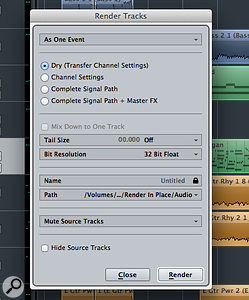Article Preview :: Cubase Tips & Techniques
Technique : Cubase NotesWhether archiving projects, creating stems or saving CPU resources, Cubase 8’s Render In Place feature has you covered.
John Walden

Whether you need to save some CPU resources in a complex project, create a set of stems for mixing and/or mastering, or simply ensure that you can either move your project to another audio environment or preserve it for archive purposes, the Render In Place facility that was added in both the Pro and Artist versions of Cubase 8 can be a really useful tool.
The Render In Place settings give you plenty of flexibility when rendering your audio or MIDI events and tracks.The Render In Place settings give you plenty of flexibility when rendering your audio or MIDI events and tracks.
Rendered Superfluous?
As the name suggests, Render In Place (RIP) provides a way of turning existing audio or virtual-instrument tracks into new audio files. RIP is not without its limitations, as we’ll see, but it is both versatile and powerful. Cubase already has a number of other tools that provide audio-rendering services, of course, including Bounce Selection, Track Freeze and Export Audio Mixdown. So does RIP render (sorry!) these existing functions superfluous? Well, yes and no, because while there’s certainly plenty of overlap between these features, and Steinberg may see RIP as an eventual replacement for some or even all of the above facilities, my educated guess is that all those older features will hang around for some time so that users with established workflows are not unduly disturbed. I’m sure that I will continue to use Export Audio Mixdown for final stereo mixdown tasks, for example, and perhaps for archiving projects, but for other tasks I can see myself turning to RIP.
Published in SOS October 2015
No comments:
Post a Comment